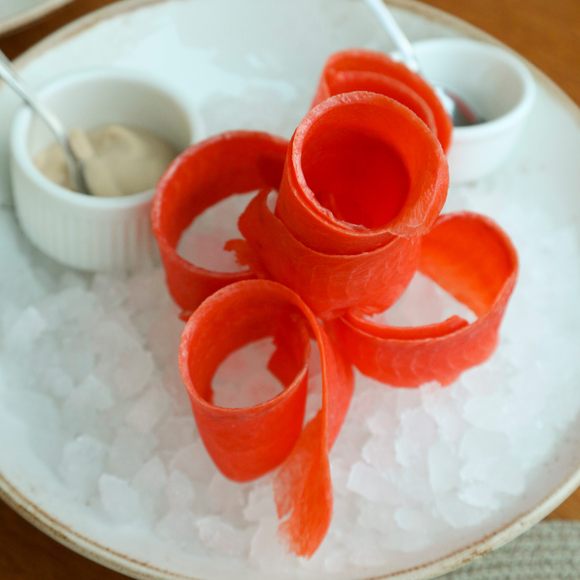Meats & Animal Products
Stroganina
This is Siberia's sashimi, a simple delicacy born in one of the world’s coldest climes.
What’s for dinner in the coldest city in the world? In Yakutsk, in Russia’s Far North, winter temperatures regularly plunge to -40 degrees Fahrenheit, so frigid your eyeglasses will freeze to your face. The local delicacy, stroganina, works with these extremes rather than against them.
Stroganina is sashimi’s Siberian cousin: a whole fish frozen raw and shaved into paper-thin slices. The dish gets its name from the Russian word strogat, which means “to plane or shave.” It’s packed with vitamins that have long helped Russia’s northernmost indigenous peoples ward off scurvy, despite the lack of fresh vegetables.
Stroganina is typically made from fatty freshwater fish, like the Arctic muksun, caught in fall or winter through holes in frozen-over rivers and lakes. Once out of the water, it freezes and must not be allowed to thaw. (Thanks to modern refrigeration, stroganina can now also be made with fish caught in warmer weather.) When it’s time to slice it, a person holds the fish vertically and carves off ribbons in long strokes using a birch-handled knife. The pieces naturally curl, and competitors at Yakutsk’s annual Stroganina Festival even fashion them into rosettes and other elaborate designs.
Stroganina is traditionally served with salt and pepper, and should melt in the mouth, not a moment before. It can also be dipped in a vinegar or tomato-based sauce. It’s also an ideal chaser—as one saying goes, only sled dogs eat stroganina without vodka.
Where to Try It
-
Expedition
Pevcheskiy pereulok 6, Moscow, RussiaIf you can't get all the way to Yakutsk or Salekhard, this Moscow restaurant serves stroganina.
-
Chohur Muran (Чочур Муран)
Vilyuyskiy Trakt 6, 5, Yakutsk, 677000, RussiaThis Yakut "ethnographic complex" has a restaurant serving stroganina and other local specialties.
Written By
 Susie Armitage
Susie Armitage
Sources
- www.yakutia.kp.ru/daily/26629.4/3647263/
- www.1sn.ru/43966.html
- roadsandkingdoms.com/2012/strogonina-frozen-sashimi-of-the-russian-arctic/
- yakutiamedia.ru/news/549394/
- xn----8sbeybxdibygm.ru-an.info/%D0%BD%D0%BE%D0%B2%D0%BE%D1%81%D1%82%D0%B8/%D1%8F%D0%BA%D1%83%D1%82%D1%81%D0%BA%D0%B0%D1%8F-%D1%81%D1%82%D1%80%D0%BE%D0%B3%D0%B0%D0%BD%D0%B8%D0%BD%D0%B0-%D0%BB%D1%83%D1%87%D1%88%D0%B8%D0%B9-%D0%B4%D0%B5%D0%BB%D0%B8%D0%BA%D0%B0%D1%82%D0%B5%D1%81-%D0%B2-%D0%BC%D0%B8%D1%80%D0%B5-%D1%84%D0%BE%D1%82%D0%BE%D1%80%D0%B5%D0%BF%D0%BE%D1%80%D1%82%D0%B0%D0%B6-%D0%BE%D0%B1-%D1%8D%D0%BA%D0%B7%D0%BE%D1%82%D0%B8%D1%87%D0%B5%D1%81%D0%BA%D0%BE%D0%BC-%D0%BB%D0%B0%D0%BA%D0%BE%D0%BC%D1%81%D1%82%D0%B2%D0%B5/
- www.sibrybalka.ru/recepty/stroganina/
- www.washingtonpost.com/wp-dyn/content/story/2008/05/13/ST2008051302252.html
- books.google.com/books?id=XChmCwAAQBAJ&pg=PT252&lpg=PT252&dq=stroganina+strogat&source=bl&ots=tqM8EBTyf5&sig=EXdvfady71KxxTv-_8TOOcN-oB0&hl=en&sa=X&ved=0ahUKEwjrtO7cr57aAhXFtlkKHdwUAb0Q6AEIOTAC#v=onepage&q=stroganina%20strogat&f=false















